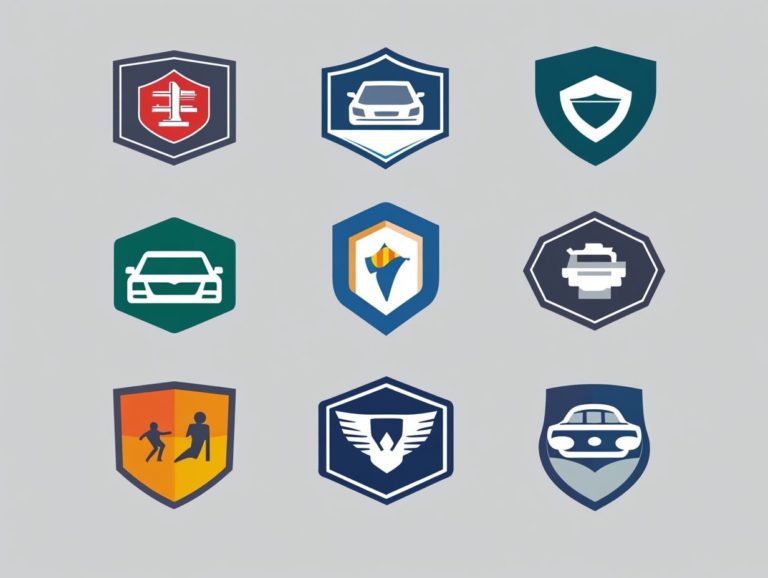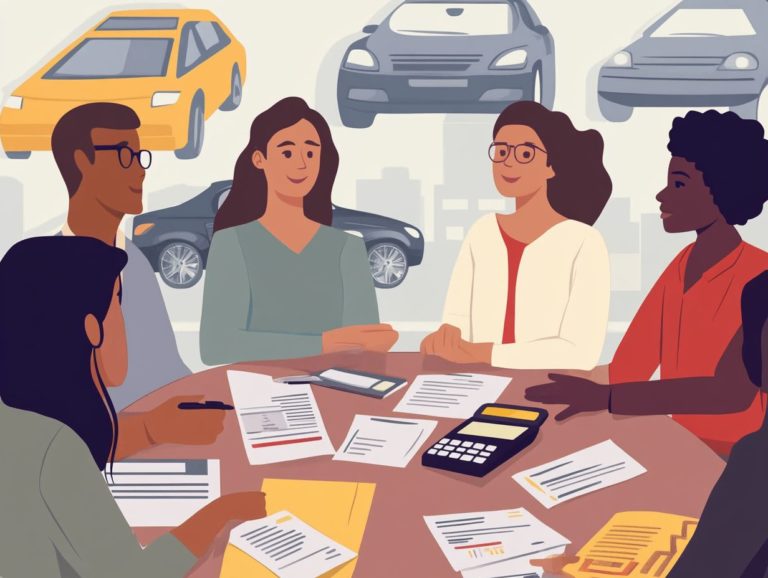How to Interpret Auto Insurance Policy Terms
Navigating the realm of auto insurance can feel daunting, particularly with the dense legal jargon often accompanying policy documents. Grasping key terms such as deductibles, premiums, and coverage limits can greatly affect your ability to select the right policy tailored to your needs.
This article breaks down essential auto insurance terminology, highlighting commonly misunderstood phrases while providing practical tips for analyzing your policy. By the end, you ll be well-equipped to make informed decisions about your coverage, steering clear of costly pitfalls along the way.
Contents
- Key Takeaways:
- Understanding Auto Insurance Policy Terms
- Key Terms in an Auto Insurance Policy
- Interpreting Policy Language
- Tips for Reading and Analyzing Your Policy
- Frequently Asked Questions
- What is an auto insurance policy?
- What are the different types of auto insurance policies?
- How do I interpret the coverage limits of my auto insurance policy?
- What does the deductible mean in an auto insurance policy?
- How do I know if a particular incident is covered under my auto insurance policy?
- What should I do if I don’t understand a term or provision in my auto insurance policy?
Key Takeaways:

- Learn the key terms to empower your understanding of auto insurance.
- Understand policy language to avoid coverage gaps and misunderstandings.
- When reading your policy, look for potential gaps in coverage, and reach out to your insurance provider with any questions.
Understanding Auto Insurance Policy Terms
Understanding the various terms associated with a personal auto insurance policy is essential for securing adequate financial protection against damages and liabilities from accidents, especially when learning how to understand your insurance policy coverage.
An auto insurance policy acts as a legally binding agreement between you and the insurance company. It outlines the coverage amounts, types of coverage, required coverage, and policy limits.
By familiarizing yourself with these terms, you can navigate your auto insurance options with confidence. This knowledge helps you choose the right auto insurance coverage to protect yourself from potential financial losses in the event of an accident.
What is an Auto Insurance Policy?
An auto insurance policy represents a comprehensive contract designed to provide you with financial protection against the myriad risks associated with owning a vehicle, including damages from accidents and liabilities.
This policy typically encompasses several key components, each thoughtfully crafted to meet your specific needs. Among these, liability insurance is particularly vital. It covers damages to other parties when you are at fault in an accident.
The insurance company plays a crucial role in customizing your personal auto policy, tailoring the coverage to align with your unique driving habits and the type of vehicle you own. Understanding the fundamental structure of your policy is essential; it serves as a pivotal tool for managing risk, offering you peace of mind and financial stability in life s unpredictable events.
Why is it Important to Understand the Terms?
It’s crucial to understand auto insurance policies to ensure you possess adequate liability coverage and financial protection against potential accidents.
Misinterpreting essential concepts such as coverage amounts, policy limits, and insurance exclusions can leave you vulnerable in the unfortunate event of a mishap. For example, if you assume your coverage automatically includes rental car costs after an accident without checking your policy limits or exclusions, you might end up paying for a car you didn t even damage.
Underestimating coverage amounts can lead to insufficient financial support to cover repair costs after an accident. This could result in unexpected out-of-pocket expenses that could have been easily avoided with a clearer understanding of the terms. Stay informed! Consult your insurance agent whenever you have doubts to ensure you are genuinely protected.
Key Terms in an Auto Insurance Policy
Navigating an auto insurance policy demands a keen understanding of essential terms that shape your coverage and financial obligations. For clarity, it’s helpful to know how to understand insurance jargon such as deductible amounts, premium costs, and any exclusions that may apply.
Familiarity with these key elements will empower you to make informed decisions about your insurance needs. Don t wait until it s too late understand your policy now to avoid costly mistakes later!
Knowing your policy inside and out can save you money and stress take charge of your coverage today!
Deductible

A deductible is the amount you decide to pay out-of-pocket before your insurance coverage kicks in for any claims made under your policy.
Wondering how deductibles affect your premiums? They can make a big difference! Understanding how deductibles operate is essential for managing your insurance costs effectively.
For instance, if you find yourself in an accident that causes significant damage, the deductible you choose can greatly impact your overall premium. Opting for a high deductible often results in lower monthly premiums, which can be tempting if you expect to make minimal claims. On the flip side, a low deductible typically leads to higher premium costs but offers more immediate financial relief in the event of an accident.
For example, if you have a $1,000 deductible and face a $5,000 repair bill, you would cover the first $1,000, while your insurer takes care of the remaining $4,000. This choice is vital in liability cases, where financial responsibilities can escalate rapidly.
Premium
The insurance premium is the periodic payment you make to maintain your auto insurance coverage, and it can fluctuate based on various factors like coverage amounts, driving history, and the type of vehicle you own.
Calculating these premiums involves a careful review of your individual risk profile. Insurers typically take into account your age, geographic location, and even your credit score when determining your rates. Each of these factors plays a significant role in shaping the final cost of your policy.
Understanding the balance between the premium amount and the level of coverage is crucial; generally, a higher premium means more comprehensive protection. Therefore, it s wise to compare quotes from different insurance companies. This not only helps you pinpoint competitive rates but also ensures you secure a policy that offers the right level of coverage tailored to your specific needs.
Coverage Limits
Coverage limits represent the maximum amount your insurance company will disburse for a particular claim, and understanding these limits is essential for effective liability insurance.
By familiarizing yourself with the specific types of coverage limits, you can be better prepared. Coverage typically falls into three primary categories:
- Per accident limits: These cap the total payout for all claims stemming from a single accident.
- Per person limits: This ensures a maximum payout for each injured individual.
- Total limits: These aggregate the total payouts for all claims within a specified timeframe.
Higher coverage limits offer peace of mind. They also protect you from financial struggles in case of significant claims. Choosing higher coverage limits not only brings peace of mind but also promotes better long-term financial stability.
Exclusions
Insurance exclusions are specific conditions or circumstances that your auto insurance policy doesn t cover, so it s important to read them carefully.
These exclusions can have significant implications, especially when unexpected incidents arise. For instance, if you were to operate your vehicle under the influence of drugs or alcohol, you might discover that any resulting damages wouldn t be compensated, leaving you in a precarious financial situation.
Similarly, using your personal vehicle for commercial purposes like delivering goods or participating in ride-sharing services can complicate your claims process. By understanding these exclusions, you can grasp how these restrictions may impact your overall coverage and explore additional insurance options that are tailored to your specific needs.
Interpreting Policy Language
Interpreting the intricate language often found in auto insurance policies is essential for grasping your insurance agreement fully and understanding how to read an auto insurance policy to ensure that you possess the appropriate coverage.
Understanding these details gives you the power to make informed decisions about your protection on the road. Take the time to review it now!
Commonly Misunderstood Terms

Some commonly misunderstood terms in auto insurance policies include liability insurance, comprehensive coverage, and collision coverage. For residents in Vermont, understanding 5 key auto insurance terms is essential for making informed decisions.
These terms are crucial for you as a policyholder since they are key to understanding your coverage and can determine how claims are processed after an accident or damage to your vehicle. For more details, check out the top 5 tips for understanding your auto insurance policy.
Liability insurance shields you from legal responsibility for injuries or damages you may cause to others. Comprehensive coverage protects against incidents unrelated to collisions, such as theft or natural disasters. Collision coverage takes care of damages to your own vehicle resulting from a collision, regardless of who s at fault.
Understanding these distinctions helps you choose the right coverage tailored to your needs, avoiding unexpected out-of-pocket expenses.
How to Clarify Confusing Language
To unravel confusing language in your auto insurance policy, it s wise to reach out to your insurance agent or company representatives who can offer valuable insights.
Before you engage in that conversation, prepare a list of specific questions about any unclear terms or clauses. This approach helps you have a better discussion, enabling a clearer understanding of your coverage and responsibilities.
By grasping the complex language of your policy, you empower yourself to make informed decisions and avoid costly mistakes. Achieving clarity not only eases stress but also gives you the power to advocate effectively for your needs in any insurance-related matters.
Tips for Reading and Analyzing Your Policy
Delving into your auto insurance policy is crucial for grasping the full spectrum of your coverage options and understanding the importance of understanding coverage terms to identify potential pitfalls within the contract.
When you read and analyze your policy, you empower yourself to make informed decisions and navigate the complexities of insurance with confidence.
What to Look for in Your Policy
When reviewing your auto insurance policy, focus on key aspects like coverage amounts, the insurance premium, and specific terms that will impact your financial protection.
It s essential to examine the limits of liability specified in your policy, as these determine how much the insurer will pay in the unfortunate event of an accident.
Understanding the types of coverage you ve selected such as comprehensive, collision, and liability ensures you re adequately safeguarded against potential risks.
Don t overlook endorsements or riders that could enhance your coverage. Options like rental car reimbursement or roadside assistance offer additional convenience and peace of mind when life throws you a curveball.
How to Spot Potential Gaps in Coverage
Spotting potential gaps in your auto insurance coverage requires a thorough examination of your policy to ensure you re fully equipped to meet your financial responsibilities in the event of an accident.
By carefully reviewing each section of your policy, you can pinpoint critical areas where you might be underinsured or missing essential protections.
Lacking coverage like uninsured motorist protection leaves you vulnerable to financial strain if you find yourself in a hit-and-run situation or in an accident with an uninsured driver.
Don’t wait schedule a review with an insurance agent today! They can offer tailored recommendations and discuss the advantages of raising your liability limits or adding necessary coverages, allowing you to craft a more comprehensive policy that truly protects you.
Frequently Asked Questions

What is an auto insurance policy?
An auto insurance policy is a contract between you and an insurance company that outlines the terms and conditions of your coverage, so it’s helpful to refer to tips for understanding complex coverage terms.
Take control of your auto insurance today!
What are the different types of auto insurance policies?
There are several types of auto insurance policies: liability, collision, comprehensive, and personal injury protection (PIP).
Each type offers different coverage. Choose the one that best fits your needs.
How do I interpret the coverage limits of my auto insurance policy?
The coverage limits indicate the maximum amount your insurer will pay for a claim.
For instance, if your liability limit is $50,000, that s the most your insurer will cover for damages you cause in an accident.
What does the deductible mean in an auto insurance policy?
A deductible is the amount you must pay before your insurance kicks in.
If your car has $1,000 in damages and your deductible is $500, you ll pay $500, and your insurer will cover the rest.
How do I know if a particular incident is covered under my auto insurance policy?
To find out if an incident is covered, carefully read your policy.
If you have questions, contact your insurance agent for help.
What should I do if I don’t understand a term or provision in my auto insurance policy?
If you encounter an unfamiliar term, reach out to your insurance agent for clarification.
Understanding your coverage is crucial for your protection.






